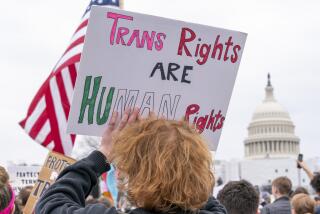Op-Ed: Finally, the Supreme Court is taking up gun rights again
- Share via
On Tuesday, the Supreme Court granted review of a case involving the constitutional right to keep and bear arms. The case challenges a New York City law that prohibits transporting handguns, even licensed and unloaded ones, to places outside of the city, including to a second home or a shooting range.
For the last decade, the high court has been missing in action on the 2nd Amendment. In 2008, the court found, for the first time, that the 2nd Amendment recognizes an individual right to bear arms (District of Columbia vs. Heller). Two years later it ruled in McDonald vs. City of Chicago that the 2nd Amendment applied to city and state laws, not just federal ones.
Ever since, there has been deafening silence. Until this week, the Supreme Court has steadfastly refused to hear another gun control case, and liberal state and local governments have taken advantage of this judicial neglect to methodically chip away at gun rights.
That is not how the court normally operates. Once it clarifies a constitutional right, the court usually hears a stream of cases to guide lower court implementation. After Brown vs. Board of Education struck down racial segregation in public schools, for example, it took three decades for the court to finish applying the decision to other institutions and to articulate principles to guide remedial plans. The lower courts and resistant states took years to get the message.
The courts should not be allowed to delete parts of the Constitution they don’t like through creative judicial editing.
The court’s reluctance to protect the 2nd Amendment beyond its first, halting steps, may stem from its own tentative reasoning. The constitutional text declares: “A well-regulated Militia, being necessary to the security of a free State, the right of the people to keep and bear Arms, shall not be infringed.” Liberals have long argued that this language only protects the right of a state to create a militia, not an individual right to own and use firearms. In Heller, however, Justice Antonin Scalia, writing for the majority, concluded that the 2nd Amendment recognized an individual natural right of self-defense that preexisted the Constitution.
Heller sparked claims that conservative judicial activists had invented a right to bear arms that went beyond the Constitution’s text. So the court must now ground the right more securely in the constitutional firmament. The Roberts court — expected to be more conservative with the replacement of the unpredictable Anthony M. Kennedy with Brett M. Kavanaugh — can achieve this by further rooting the 2nd Amendment’s text in the broader framework of natural rights.
The founding generation believed in natural law and natural rights, and the Constitution is steeped in that belief. As the Declaration of Independence declared, all men, as rational beings created by God, possessed certain inalienable rights. One of these rights, many of the great political philosophers of the day noted, was the right to self-defense. The 2nd Amendment incorporates an understanding of the breadth and scope of that natural right.
With its overdue decision to hear another 2nd Amendment case, the court can finally elevate the right to keep and bear arms to the same level as the others in the Bill of Rights. Often, the Supreme Court provides in its rulings a test lower courts can apply to determine whether a constitutional right has been infringed.
Up to now, the court has failed to articulate any test to protect gun rights, allowing lower courts to do as they please. So they have upheld 10-day waiting periods before a firearm purchase, bans on semiautomatic rifles and large-capacity magazines, and prohibitions on carrying a firearm, either openly, concealed, or both. Hence, courts have allowed governments to trample gun rights with only superficial justification, in ways inconceivable if the right at issue was speech or privacy. And for the last decade, the Supreme Court has only looked the other way.
Enter the Fray: First takes on the news of the minute »
To ensure the equal treatment of constitutional rights, the court should establish a test fully rooted in the original understanding of the Constitution and the Bill of Rights. This would require examining firearms regulations around the time of the enactment of the 2nd Amendment. This would also require adopting a natural rights framework that presumptively allows the exercise of the right to bear arms until it infringes on another’s equal rights, or causes physical harm to a person or property. The Constitution, for example, would not allow the 2nd Amendment to justify shooting a person or damaging property except in self-defense.
Resolving the conflict between reasonable regulations and the constitutional right to bear arms, when brought forward in cases with real facts, will allow the Roberts Court to finally construct a framework for the protection of the 2nd Amendment, and compel the lower courts and state governments to follow it.
Far too often for too long, the 2nd Amendment has been a second-class right, banished to the back of the constitutional bus. If the American people want to ban guns to curb criminal violence, they can. But they must first amend the Constitution. The courts should not be allowed to delete parts of the Constitution they don’t like through creative judicial editing. That is what led to one of the Supreme Court’s greatest sins: allowing racial segregation for so long.
Until the people decide otherwise, the court’s constitutional duty is to keep enforcing the right to keep and bear arms just as it would any other constitutional right. The Constitution does not elevate some rights over others, and neither should the court.
James Phillips is a nonresident fellow with Stanford Law School’s Constitutional Law Center and an attorney in private practice. John Yoo is a law professor at UC Berkeley, a visiting scholar at the American Enterprise Institute and a visiting fellow at the Hoover Institution.
More to Read
A cure for the common opinion
Get thought-provoking perspectives with our weekly newsletter.
You may occasionally receive promotional content from the Los Angeles Times.










